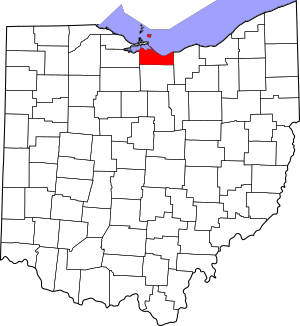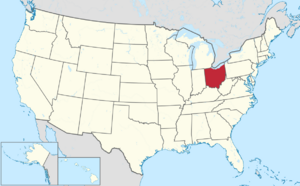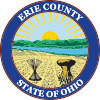Erie County, Ohio facts for kids
Quick facts for kids
Erie County
|
|||
|---|---|---|---|

|
|||
|
|||

Location within the U.S. state of Ohio
|
|||
 Ohio's location within the U.S. |
|||
| Country | |||
| State | |||
| Founded | March 16, 1838 | ||
| Named for | Erie tribe | ||
| Seat | Sandusky | ||
| Largest city | Sandusky | ||
| Area | |||
| • Total | 626 sq mi (1,620 km2) | ||
| • Land | 252 sq mi (650 km2) | ||
| • Water | 374 sq mi (970 km2) 60%% | ||
| Population
(2020)
|
|||
| • Total | 75,622 |
||
| • Density | 120/sq mi (50/km2) | ||
| Time zone | UTC−5 (Eastern) | ||
| • Summer (DST) | UTC−4 (EDT) | ||
| Congressional district | 9th | ||
Erie County is a county in the northern portion of the U.S. state of Ohio. As of the 2020 census, the population was 75,622. Its county seat and largest city is Sandusky. The county is named for the Erie tribe, whose name was their word for "wildcat". It was formed in 1838 from the northern third of Huron County and a portion of Sandusky County.
Erie County is included in the Sandusky, OH Metropolitan Statistical Area, which is also included in the Cleveland-Akron-Canton, OH Combined Statistical Area.
Contents
History
Erie County was created in 1838 from a portion of Huron County. A few subsequent changes to Erie County's boundaries occurred shortly after its initial formation.
Geography
According to the U.S. Census Bureau, the county has a total area of 626 square miles (1,620 km2), of which 252 square miles (650 km2) is land and 374 square miles (970 km2) (60%) is water. It is the second-smallest county in Ohio by land area after Lake County. The county is bordered on the north by Lake Erie; the opposite shore is made up of two counties in Ontario, Canada.
It is drained by the Huron and Vermilion rivers. Near the Huron River are several ancient earthwork mounds and enclosures constructed by early indigenous peoples. Sandusky has extensive quarries of valuable limestone. The surface is generally level, and the soil alluvial and exceedingly fertile.
Adjacent counties and municipalities
- Essex County, Ontario (north, across Lake Erie)
- Chatham-Kent municipality, Ontario (north, across Lake Erie)
- Lorain County (east)
- Huron County (south)
- Sandusky County (west)
- Ottawa County (northwest)
Major highways

 I-80 / I-90 (Ohio Turnpike)
I-80 / I-90 (Ohio Turnpike) US 6
US 6 US 250
US 250 SR 2
SR 2 SR 4
SR 4 SR 13
SR 13 SR 60
SR 60 SR 61
SR 61 SR 99
SR 99 SR 101
SR 101 SR 113
SR 113 SR 269
SR 269
Demographics
| Historical population | |||
|---|---|---|---|
| Census | Pop. | %± | |
| 1840 | 12,599 | — | |
| 1850 | 18,568 | 47.4% | |
| 1860 | 24,474 | 31.8% | |
| 1870 | 28,188 | 15.2% | |
| 1880 | 32,640 | 15.8% | |
| 1890 | 35,462 | 8.6% | |
| 1900 | 37,650 | 6.2% | |
| 1910 | 38,327 | 1.8% | |
| 1920 | 39,789 | 3.8% | |
| 1930 | 42,133 | 5.9% | |
| 1940 | 43,201 | 2.5% | |
| 1950 | 52,565 | 21.7% | |
| 1960 | 68,000 | 29.4% | |
| 1970 | 75,909 | 11.6% | |
| 1980 | 79,655 | 4.9% | |
| 1990 | 76,779 | −3.6% | |
| 2000 | 79,551 | 3.6% | |
| 2010 | 77,079 | −3.1% | |
| 2020 | 75,622 | −1.9% | |
| U.S. Decennial Census 1790-1960 1900-1990 1990-2000 2020 |
|||
2010 census
As of the 2010 United States Census, there were 77,079 people, 31,860 households, and 21,011 families residing in the county. The population density was 306.4 inhabitants per square mile (118.3/km2). There were 37,845 housing units at an average density of 150.4 units per square mile (58.1 units/km2). The racial makeup of the county was 87.0% white, 8.6% black or African American, 0.6% Asian, 0.3% American Indian, 0.7% from other races, and 2.8% from two or more races. Those of Hispanic or Latino origin made up 3.4% of the population. In terms of ancestry, 38.8% were German, 15.2% were Irish, 11.7% were English, 8.5% were Italian, and 4.6% were American.
Of the 31,860 households, 29.1% had children under the age of 18 living with them, 48.5% were married couples living together, 12.9% had a female householder with no husband present, 34.1% were non-families, and 28.6% of all households were made up of individuals. The average household size was 2.37 and the average family size was 2.89. The median age was 43.4 years.
The median income for a household in the county was $46,593 and the median income for a family was $61,247. Males had a median income of $46,211 versus $32,621 for females. The per capita income for the county was $25,290. About 8.5% of families and 12.5% of the population were below the poverty line, including 17.1% of those under age 18 and 8.5% of those age 65 or over.
Education
All or part of eleven school districts serve Erie County and its residents:
- Bellevue City School District: includes parts of Bellevue and Groton Township.
- Edison Local School District: includes parts of Berlin Heights and Milan, and Berlin, Florence, Huron, Milan, Oxford, Perkins, and Vermilion Townships.
- Firelands Local School District: includes parts of Florence Township.
- Huron City School District: includes parts of Huron and Berlin, Huron, and Milan Townships.
- Kelleys Island Local School District: includes all of Kelleys Island.
- Margaretta Local School District: includes parts of Bay View and Castalia, and Groton and Margaretta Townships.
- Monroeville Local School District: includes parts of Oxford Township.
- Perkins Local School District: includes parts of Groton, Huron, Margaretta, Milan, Oxford, and Perkins Townships.
- Sandusky Central Catholic Schools: includes Sandusky's three catholic Parishes (St. Mary's, Sts. Peter & Paul, and Holy Angels).
- St. Peter's School: a private catholic elementary school in Huron
- Sandusky City School District: includes all of Sandusky.
- Vermilion Local School District: includes parts of Vermilion and Florence and Vermilion Townships.
- Western Reserve Local School District: including parts of Florence Township.
Communities
Cities
Villages
Townships
- Berlin
- Florence
- Groton
- Huron
- Margaretta
- Milan
- Oxford
- Perkins
- Vermilion
Census-designated places
Unincorporated communities
- Avery
- Axtel
- Birmingham
- Bloomingville
- Bogart
- Ceylon
- Fairview Lanes
- Florence
- Ruggles Beach
- Sandusky South
Places of interest
- Blue Hole
- Cedar Point
- Plum Brook Station
- Thomas Alva Edison Birthplace
See also
 In Spanish: Condado de Erie (Ohio) para niños
In Spanish: Condado de Erie (Ohio) para niños




